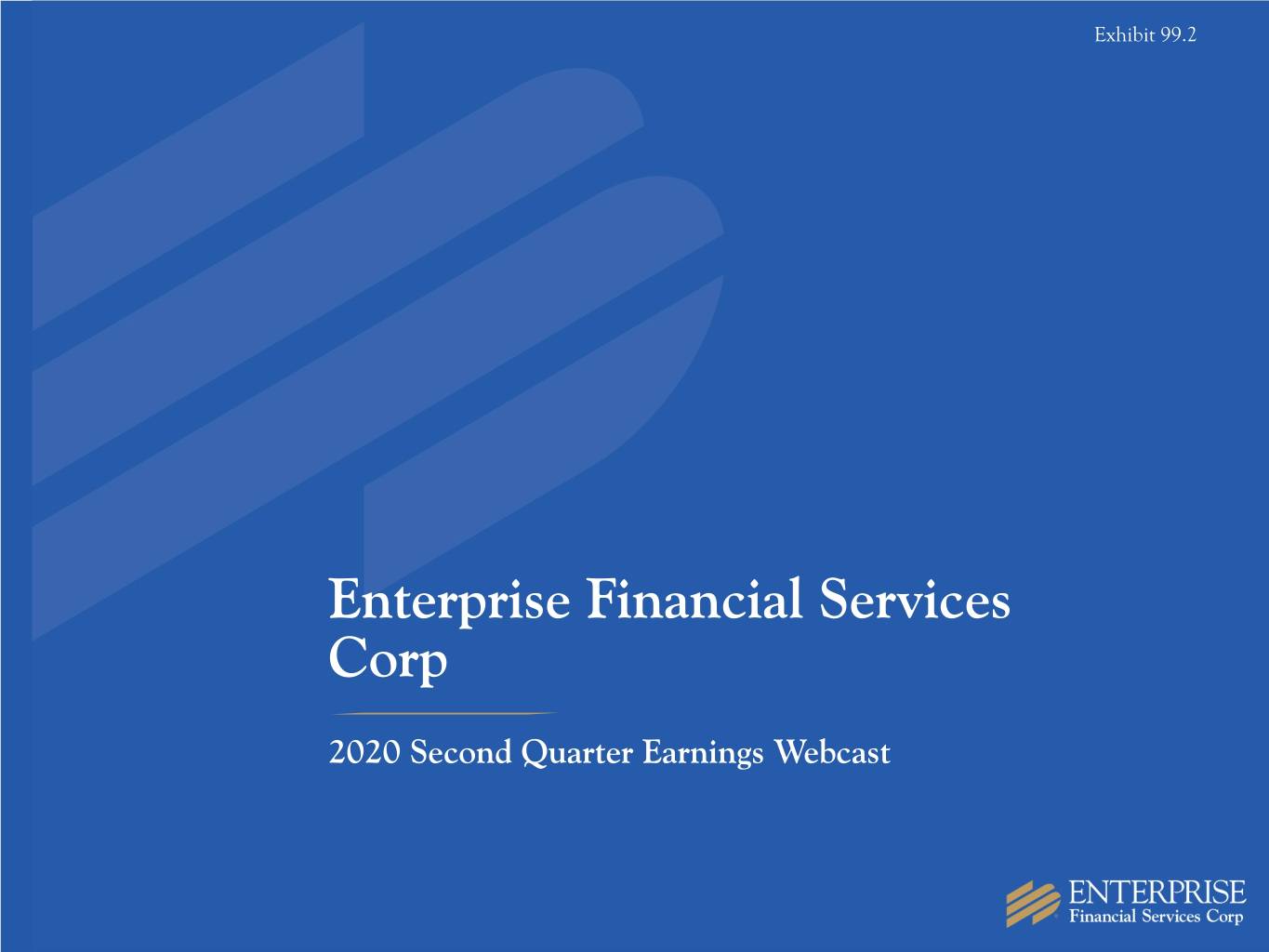
Exhibit 99.2 Enterprise Financial Services Corp 2020 Second Quarter Earnings Webcast

Forward-Looking Statements Some of the information in this report may contain “forward-looking statements” within the meaning of and intended to be covered by the safe harbor provisions of the Private Securities Litigation Reform Act of 1995. Such forward-looking statements may include projections based on management’s current expectations and beliefs concerning future developments and their potential effects on the Company including, without limitation, plans, strategies and goals, and statements about the Company’s expectations regarding revenue and asset growth, financial performance and profitability, loan and deposit growth, yields and returns, loan diversification and credit management, shareholder value creation and the impact of acquisitions. Forward-looking statements include, but are not limited to, statements about the Company’s plans, expectations, and projections of future financial and operating results, as well as statements regarding the Company’s plans, objectives, expectations or consequences of announced transactions. The Company uses words such as “may,” “might,” “will,” “should,” “expect,” “plan,” “anticipate,” “believe,” “estimate,” “predict,” “potential,” “could,” “continue,” and “intend”, and variations of such words and similar expressions, in this release to identify such forward-looking statements. Forward-looking statements are inherently subject to risks and uncertainties that could cause actual results to differ materially from those contemplated from such statements. The COVID-19 pandemic is adversely affecting us, our customers, counterparties, employees, and third-party service providers, and the ultimate extent of the impacts on our business, financial position, results of operations, liquidity, and prospects is uncertain. Continued deterioration in general business and economic conditions, including further increases in unemployment rates, or turbulence in domestic or global financial markets could adversely affect our revenues and the values of our assets and liabilities, reduce the availability of funding, lead to a tightening of credit, and further increase stock price volatility. In addition, changes to statutes, regulations, or regulatory policies or practices as a result of, or in response to COVID-19, could affect us in substantial and unpredictable ways. Other factors that could cause or contribute to such differences include, but are not limited to, the Company’s ability to efficiently integrate acquisitions, including the Trinity acquisition, into its operations, retain the customers of these businesses and grow the acquired operations, as well as credit risk, changes in the appraised valuation of real estate securing impaired loans, outcomes of litigation and other contingencies, exposure to general and local economic conditions, risks associated with rapid increases or decreases in prevailing interest rates, consolidation in the banking industry, competition from banks and other financial institutions, the Company’s ability to attract and retain relationship officers and other key personnel, burdens imposed by federal and state regulation, changes in regulatory requirements, changes in accounting policies and practices or accounting standards, including ASU 2016-13 (Topic 326), “Measurement of Credit Losses on Financial Instruments,” commonly referenced as the Current Expected Credit Loss (“CECL”) model, which changed how we estimate credit losses and may increase the required level of our allowance for credit losses after adoption on January 1, 2020, uncertainty regarding the future of LIBOR, natural disasters, war or terrorist activities, or pandemics, or the outbreak of COVID-19 or similar outbreaks, and their effects on economic and business environments in which we operate, as well as other risk factors described in the Company’s 2019 Annual Report on Form 10-K and other reports filed with the Securities and Exchange Commission (the “SEC”). Forward-looking statements speak only as of the date they are made, and the Company undertakes no obligation to update them in light of new information or future events unless required under the federal securities laws. 2
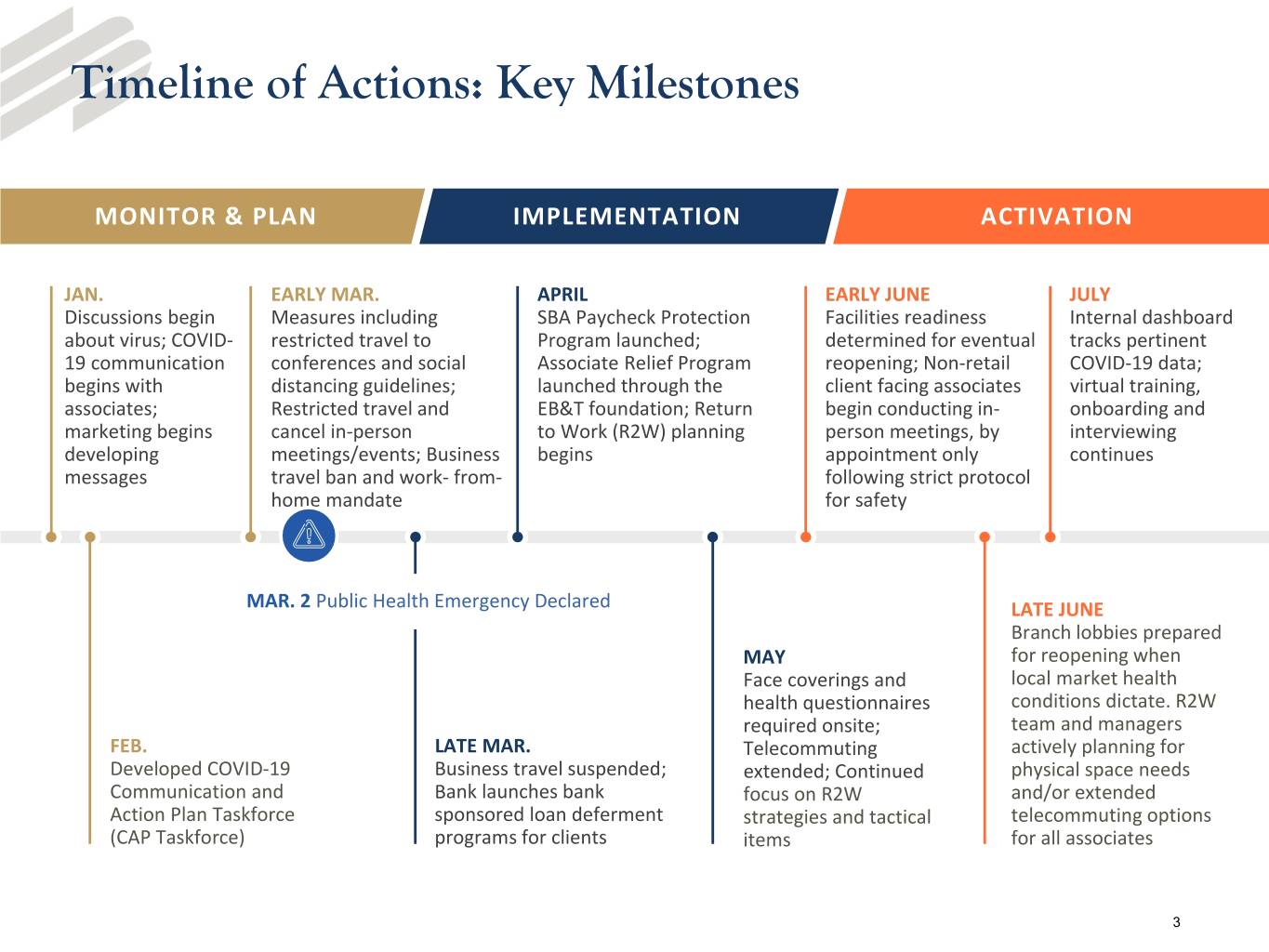
Timeline of Actions: Key Milestones MONITOR & PLANIMPLEMENTATION ACTIVATION JAN. EARLY MAR. APRIL EARLY JUNE JULY Discussions begin Measures including SBA Paycheck Protection Facilities readiness Internal dashboard about virus; COVID‐ restricted travel to Program launched; determined for eventual tracks pertinent 19 communication conferences and social Associate Relief Program reopening; Non‐retail COVID‐19 data; begins with distancing guidelines; launched through the client facing associates virtual training, associates; Restricted travel and EB&T foundation; Return begin conducting in‐ onboarding and marketing begins cancel in‐person to Work (R2W) planning person meetings, by interviewing developing meetings/events; Business begins appointment only continues messages travel ban and work‐ from‐ following strict protocol home mandate for safety MAR. 2 Public Health Emergency Declared LATE JUNE Branch lobbies prepared MAY for reopening when Face coverings and local market health health questionnaires conditions dictate. R2W required onsite; team and managers FEB. LATE MAR. Telecommuting actively planning for Developed COVID‐19 Business travel suspended; extended; Continued physical space needs Communication and Bank launches bank focus on R2W and/or extended Action Plan Taskforce sponsored loan deferment strategies and tactical telecommuting options (CAP Taskforce) programs for clients items for all associates 3
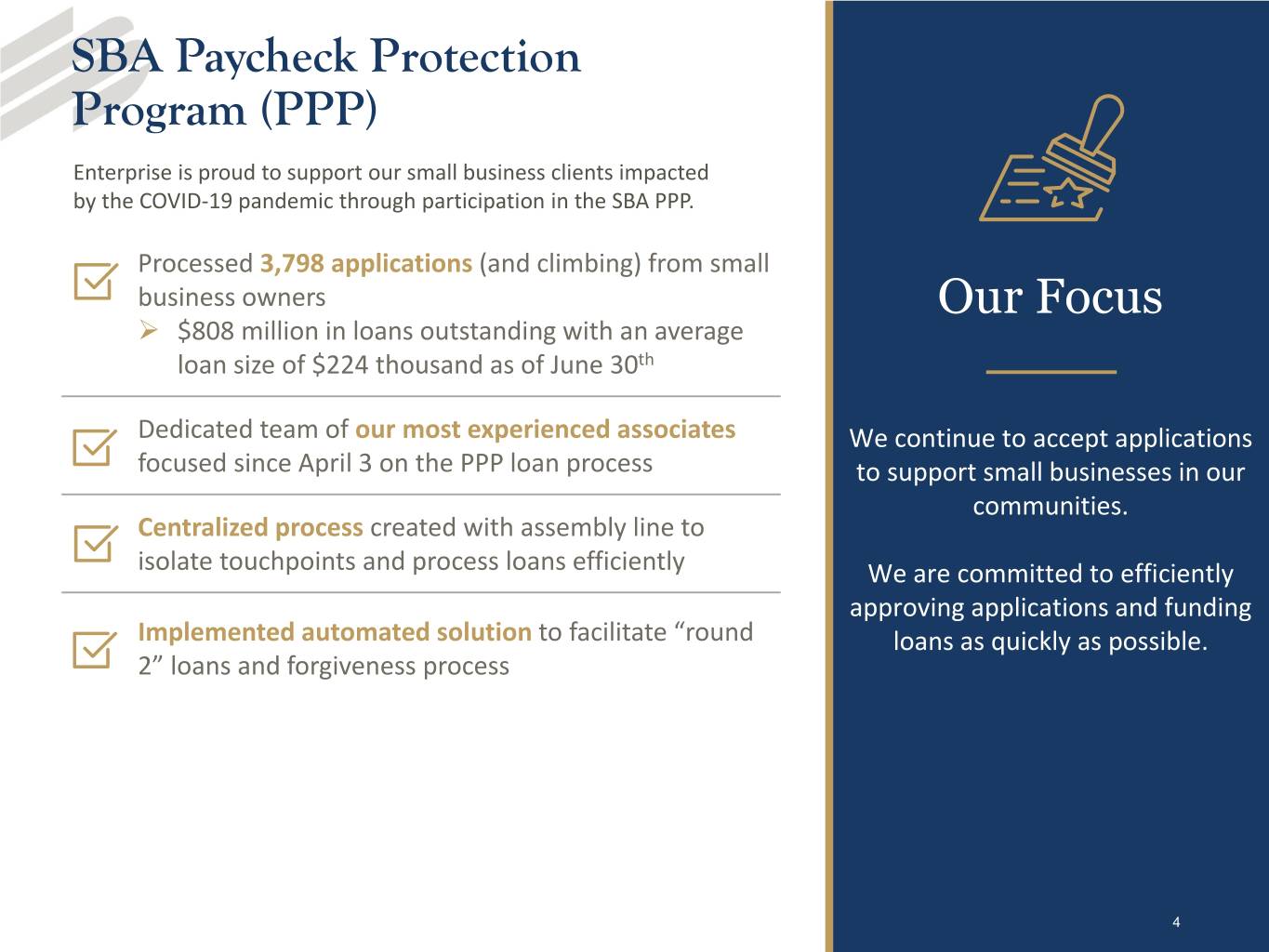
SBA Paycheck Protection Program (PPP) Enterprise is proud to support our small business clients impacted by the COVID‐19 pandemic through participation in the SBA PPP. Processed 3,798 applications (and climbing) from small business owners Our Focus $808 million in loans outstanding with an average loan size of $224 thousand as of June 30th Dedicated team of our most experienced associates We continue to accept applications focused since April 3 on the PPP loan process to support small businesses in our communities. Centralized process created with assembly line to isolate touchpoints and process loans efficiently We are committed to efficiently approving applications and funding Implemented automated solution to facilitate “round loans as quickly as possible. 2” loans and forgiveness process 4

Total Loan Trends 19% Total Loan Growth In Millions $6,140 PPP $5,458 $808 $5,314 $5,149 $5,228 Q2' 19 Q3' 19 Q4' 19 Q1' 20 Q2' 20 5

Commercial & Industrial Loan Trends In Millions 39% C&I Growth $3,143 PPP $808 $2,469 $2,361 $2,265 $2,303 Q2 '19 Q3 '19 Q4 '19 Q1 '20 Q2 '20 6

Loan Details Q2 ’20 Q1 ’20 QTR Q2 ’19 LTM In Millions Change Change C&I - General $ 1,058 $ 1,186 $ (128) $ 1,104 $ (46) CRE, Investor Owned - General 1,301 1,319 (18) 1,235 66 CRE, Owner Occupied - General 600 585 15 591 9 SBA PPP loans 808 — 808 — 808 Enterprise Value Lending1 383 441 (58) 446 (63) Life Insurance Premium Financing1 521 497 24 466 55 Residential Real Estate - General 327 346 (19) 409 (82) Construction and Land Development - General 456 446 10 377 79 Tax Credits1 363 354 9 268 95 Agriculture1 191 168 23 132 59 Other 132 116 16 121 11 Total Loans $ 6,140 $ 5,458 $ 682 $ 5,149 $ 991 1Specialized categories may include a mix of C&I, CRE, Construction and land development, or Other loans. 7

Total Loans By Business Unit In Millions Specialized Lending St.Louis Kansas City $991 $1,039 $990 $783 $832 $824 $2,339 $2,568 $2,506 Q2 '19 Q1 '20 Q2 '20 Q2 '19 Q1 '20 Q2 '20 Q2 '19 Q1 '20 Q2 '20 Arizona New Mexico $678 $636 $625 $358 $383 $387 Q2 '19 Q1 '20 Q2 '20 Q2 '19 Q1 '20 Q2 '20 Note: Q2 '20 excludes $808 million in PPP loans 8
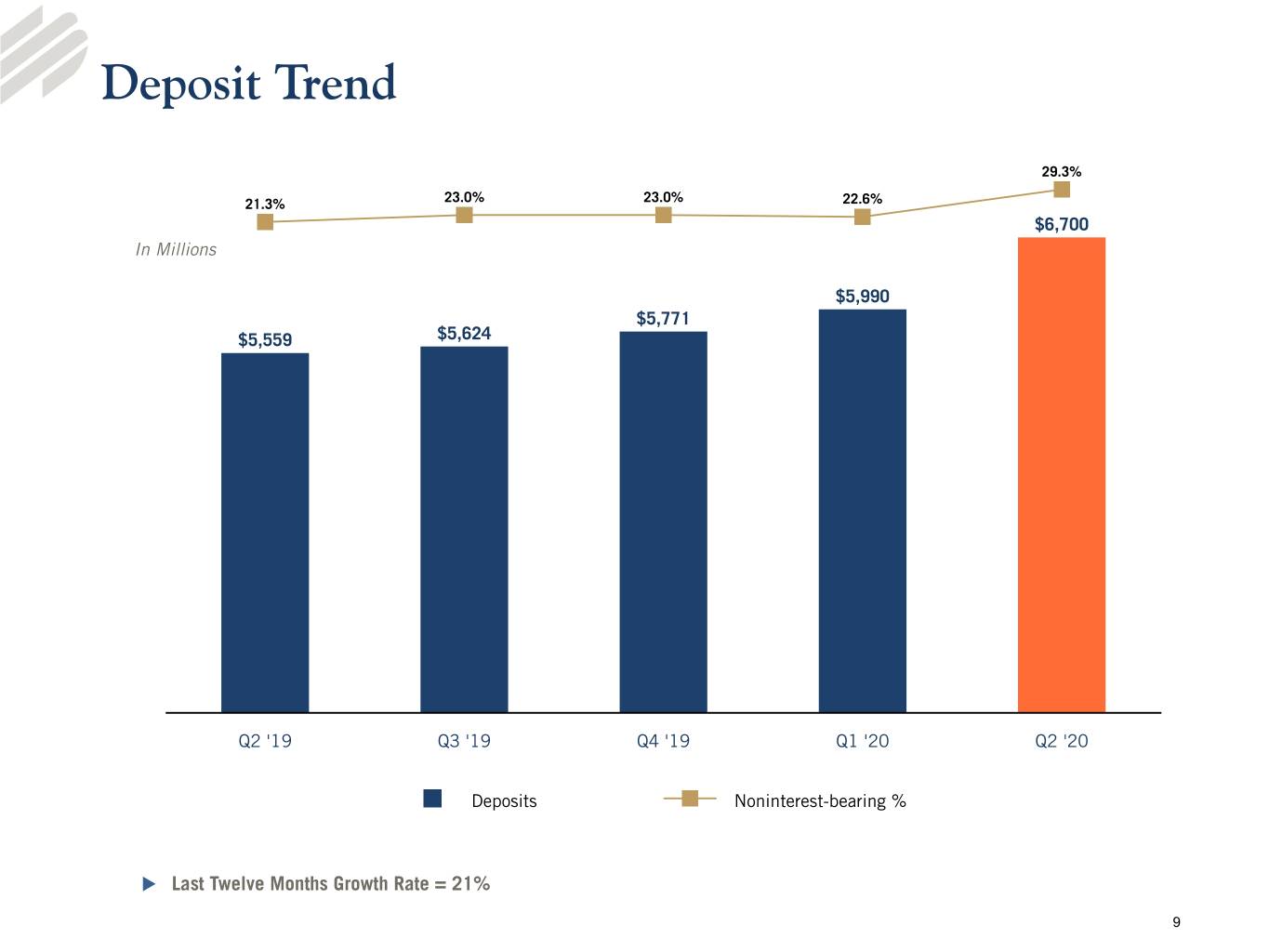
Deposit Trend 29.3% 21.3% 23.0% 23.0% 22.6% $6,700 In Millions $5,990 $5,771 $5,559 $5,624 Q2 '19 Q3 '19 Q4 '19 Q1 '20 Q2 '20 Deposits Noninterest-bearing % u Last Twelve Months Growth Rate = 21% 9

Loan Portfolio Loans by Product Type Loans by Industry Type Other Services Construction 7.4% 31.2% Residential 5.3% Accommodation Real Estate/ Other 2.2% & Food Service CRE 31.0% 5.7% Rental/Leasing 25.7% EVL 6.2% Construction 5.9% LIPF 8.5% Other Services 6.4% Finance and Tax Credit 5.9% Manufacturing Insurance 9.0% 16.1% Agriculture 3.1% C&I 17.2% PPP 13.2% LIBOR 40.9% Fixed 36.5% Loans by Total $6.1 Billion Rate Type Other Adjustable Prime PPP Fixed 4.1% 5.4% 13.1% 10
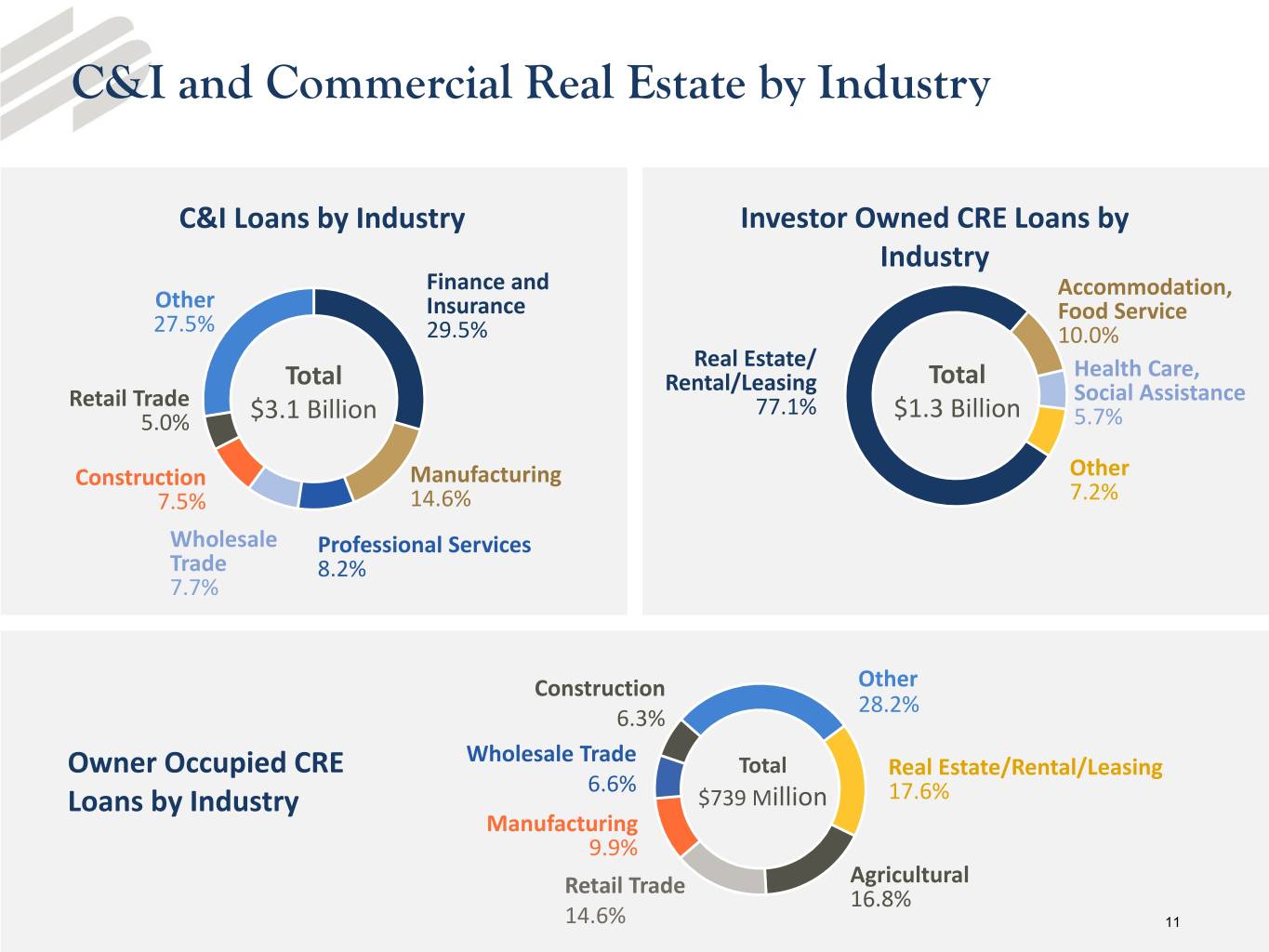
C&I and Commercial Real Estate by Industry C&I Loans by Industry Investor Owned CRE Loans by Industry Finance and Accommodation, Other Insurance Food Service 27.5% 29.5% 10.0% Real Estate/ Total Total Health Care, Rental/Leasing Social Assistance Retail Trade 77.1% 5.0% $3.1 Billion $1.3 Billion 5.7% Construction Manufacturing Other 7.5% 14.6% 7.2% Wholesale Professional Services Trade 8.2% 7.7% Construction Other 28.2% 6.3% Wholesale Trade Owner Occupied CRE Total Real Estate/Rental/Leasing 6.6% Loans by Industry $739 Million 17.6% Manufacturing 9.9% Retail Trade Agricultural 16.8% 14.6% 11

Loan Modifications Loan Modifications In Millions Loan Modifications by Loan Type Q2 ’20 Interest deferred $4.0 Residential Loans with modifications: 3.1% CRE 59.0% Commercial Real Estate $404.3 Commercial and Industrial 171.1 Construction Construction Real Estate 88.4 12.9% Residential Real Estate 21.8 Other 0.1 Total $685.7 C&I Number of modifications by month: 25.0% March April May June 59 383 99 28 Full Contractual Deferrals by Term Principal Only Deferrals by Term 90 Day 120 Day 0.3% 90 Day 150 Day 0.2% Total Total 180 Day 1.3% 90.3% $324 Million 180 Day 0.7% 88.5% $362 Million 30 Day 7.2% 60 Day 60 Day 8.7% 2.8% 12

Enterprise Value Lending (EVL) Total $383 Million EVL Loans by Industry EVL Loans by Location Southeast Other Manufacturing 20.0% 16.6% 35.0% Midwest 36.0% West Health Care 9.2% 3.8% Professional Arts & Technical Entertainment 16.1% Northeast 4.6% Southwest 20.6% Administrative & Wholesale 14.2% Support 8.7% Trade 15.2% Internally reviewed 100% of the portfolio to identify businesses most at risk for impacts from COVID‐19. EVL Loans by Size $ In Millions 30% of the portfolio is secured by working capital assets properly margined and monitored by borrowing base. Size Number of Loans Balance Average Balance 60%+ of the portfolio companies have received PPP funding > $10 Million 4 $66.5 $16.6 90% of the portfolio is sponsored by a Small Business Investment $5‐10 Million 14 95.9 6.8 Company (“SBIC”) licensed by the SBA $2‐5 Million 44 135.8 3.1 Top 10 Sponsors make up half of the EVL portfolio Average 8‐year relationship and 10 deals < $2 Million 102 85.3 1.2 Independent external review (completed July 2020) of portfolio with 78% Total 164 $383.5 $2.3 penetration confirmed bank’s risk recognition and further stressed 13 portfolio for LGD in various economic recoveries
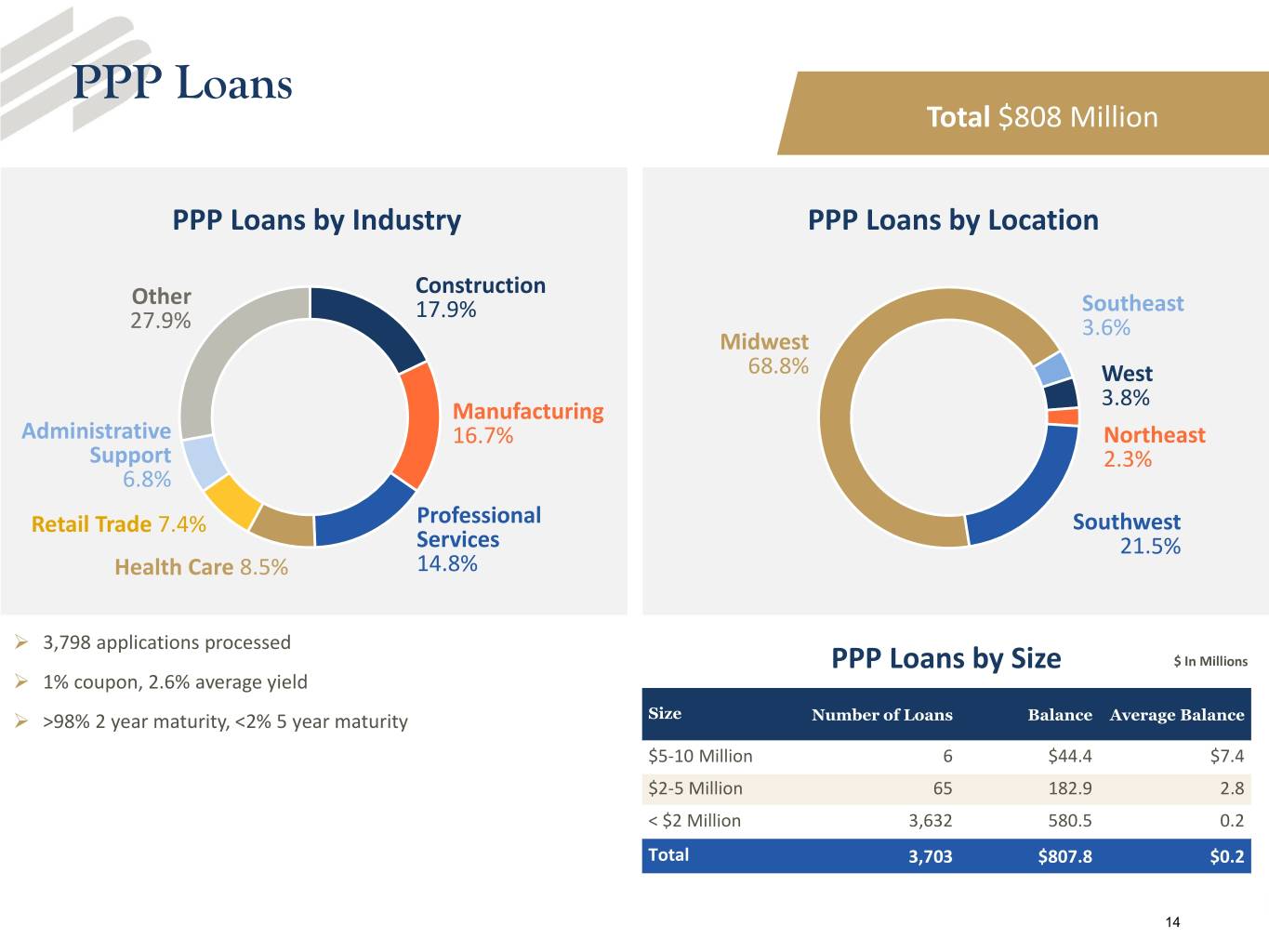
PPP Loans Total $808 Million PPP Loans by Industry PPP Loans by Location Other Construction 17.9% Southeast 27.9% 3.6% Midwest 68.8% West 3.8% Manufacturing Administrative 16.7% Northeast Support 2.3% 6.8% Retail Trade 7.4% Professional Southwest Services 21.5% Health Care 8.5% 14.8% 3,798 applications processed PPP Loans by Size $ In Millions 1% coupon, 2.6% average yield >98% 2 year maturity, <2% 5 year maturity Size Number of Loans Balance Average Balance $5‐10 Million 6 $44.4 $7.4 $2‐5 Million 65 182.9 2.8 < $2 Million 3,632 580.5 0.2 Total 3,703 $807.8 $0.2 14
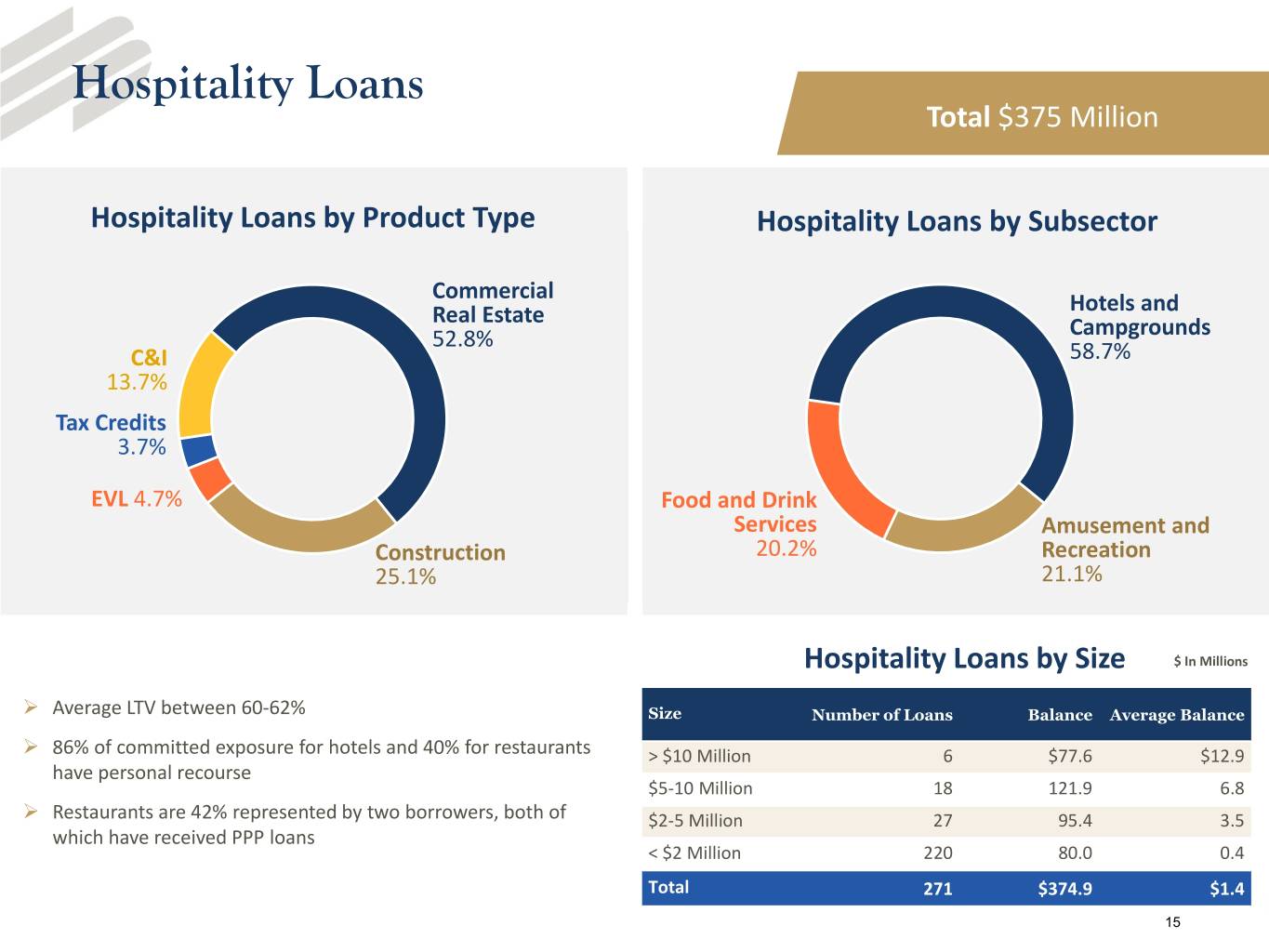
Hospitality Loans Total $375 Million Hospitality Loans by Product Type Hospitality Loans by Subsector Commercial Real Estate Hotels and 52.8% Campgrounds C&I 58.7% 13.7% Tax Credits 3.7% EVL 4.7% Food and Drink Services Amusement and Construction 20.2% Recreation 25.1% 21.1% Hospitality Loans by Size $ In Millions Average LTV between 60‐62% Size Number of Loans Balance Average Balance 86% of committed exposure for hotels and 40% for restaurants > $10 Million 6 $77.6 $12.9 have personal recourse $5‐10 Million 18 121.9 6.8 Restaurants are 42% represented by two borrowers, both of $2‐5 Million 27 95.4 3.5 which have received PPP loans < $2 Million 220 80.0 0.4 Total 271 $374.9 $1.4 15
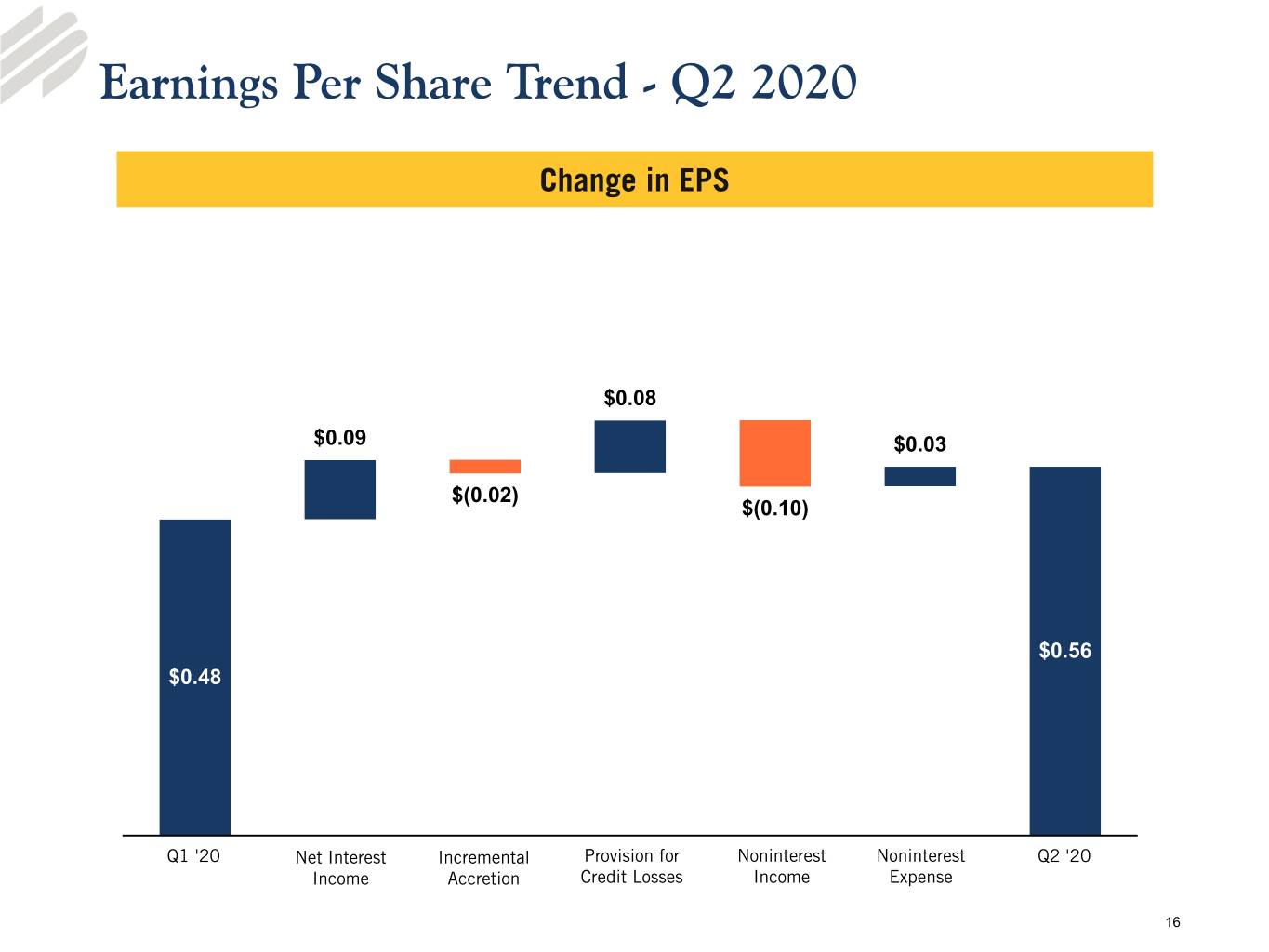
Earnings Per Share Trend - Q2 2020 Change in EPS $0.08 $0.09 $0.03 $(0.02) $(0.10) $0.56 $0.48 Q1 '20 Net Interest Incremental Provision for Noninterest Noninterest Q2 '20 Income Accretion Credit Losses Income Expense 16
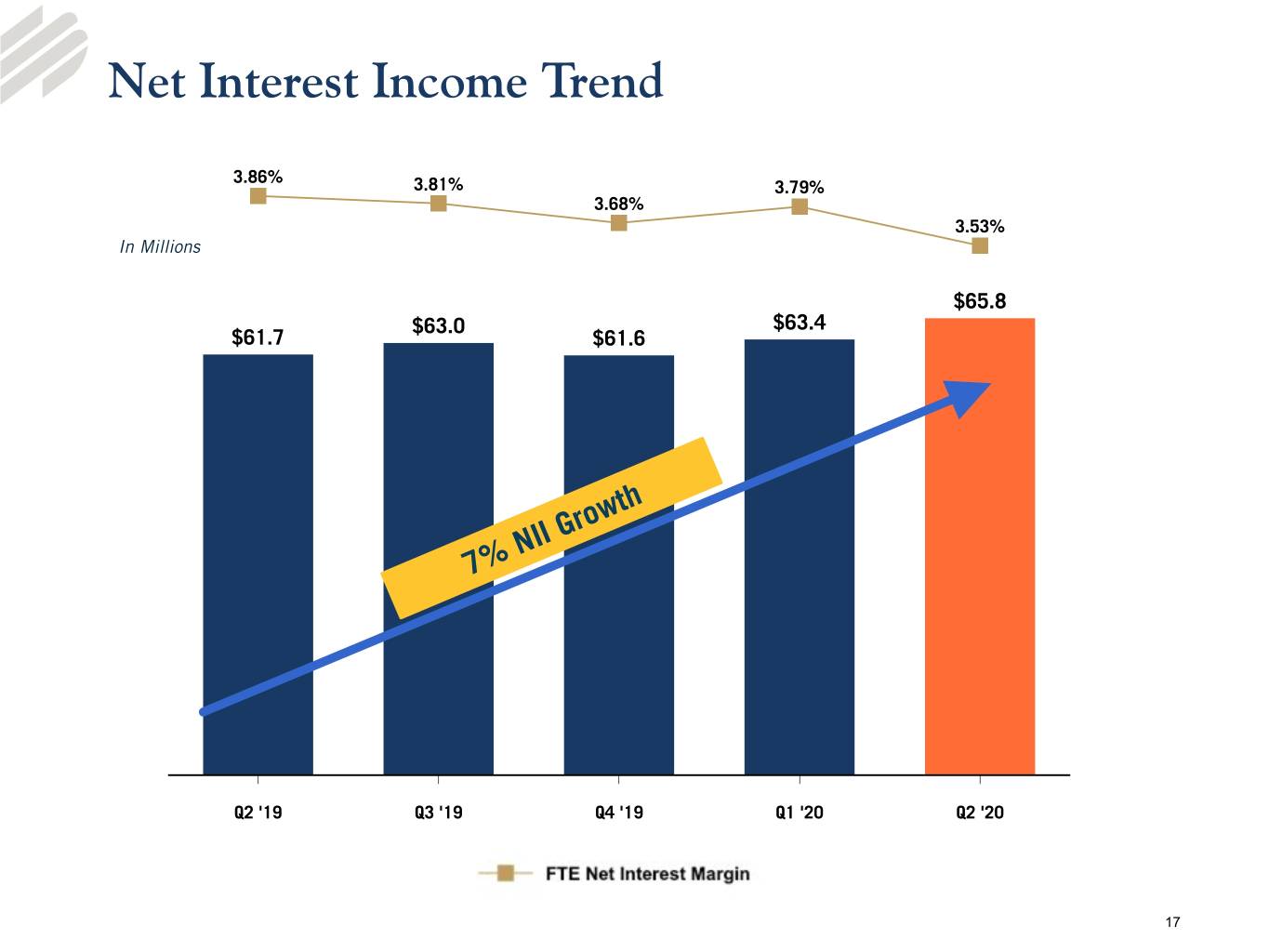
Net Interest Income Trend 3.86% 3.81% 3.79% 3.68% 3.53% In Millions $65.8 $63.0 $63.4 $61.7 $61.6 7% NII Growth Q2 '19 Q3 '19 Q4 '19 Q1 '20 Q2 '20 17
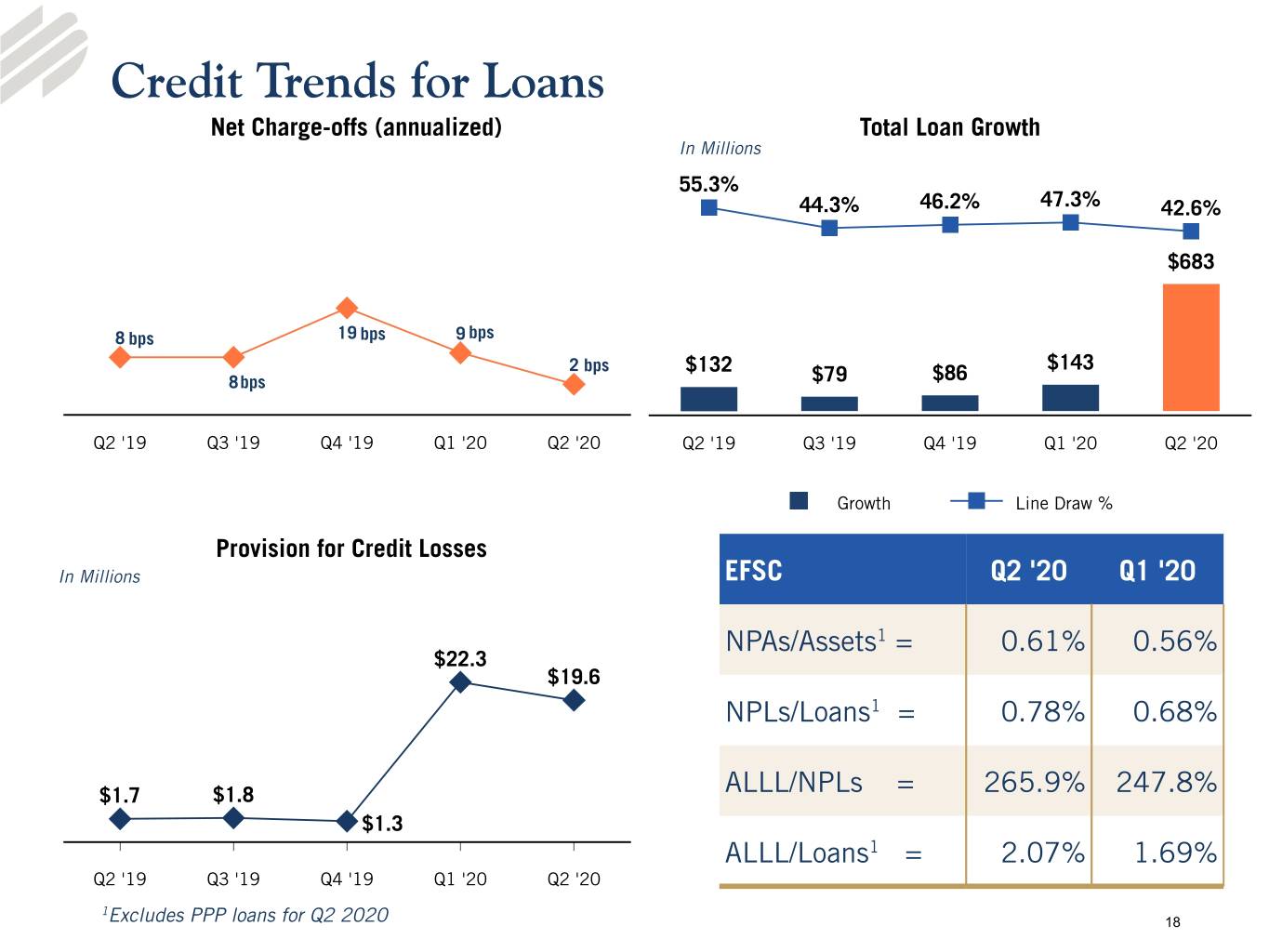
Credit Trends for Loans Net Charge-offs (annualized) Total Loan Growth In Millions 55.3% 44.3% 46.2% 47.3% 42.6% $683 8 bps 19 bps 9 bps 2 bps $132 $143 8bps $79 $86 Q2 '19 Q3 '19 Q4 '19 Q1 '20 Q2 '20 Q2 '19 Q3 '19 Q4 '19 Q1 '20 Q2 '20 Growth Line Draw % Provision for Credit Losses In Millions EFSC Q2 '20 Q1 '20 NPAs/Assets1 = 0.61% 0.56% $22.3 $19.6 NPLs/Loans1 = 0.78% 0.68% $1.7 $1.8 ALLL/NPLs = 265.9% 247.8% $1.3 ALLL/Loans1 = 2.07% 1.69% Q2 '19 Q3 '19 Q4 '19 Q1 '20 Q2 '20 1 Excludes PPP loans for Q2 2020 18
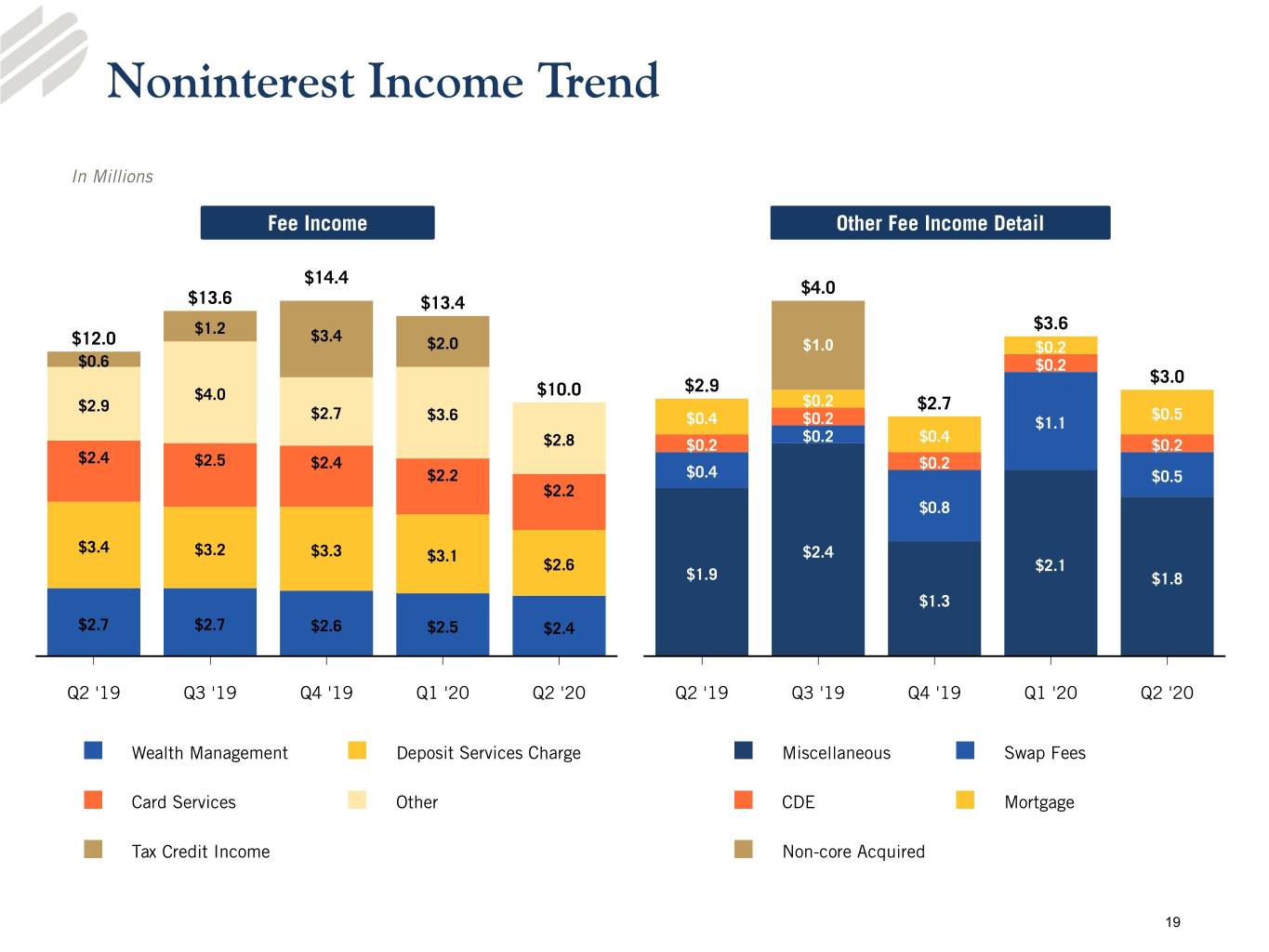
Noninterest Income Trend In Millions Fee Income Other Fee Income Detail $14.4 $4.0 $13.6 $13.4 $3.6 $1.2 $3.4 $12.0 $2.0 $1.0 $0.2 $0.6 $0.2 $3.0 $4.0 $10.0 $2.9 $2.9 $0.2 $2.7 $2.7 $3.6 $0.5 $0.4 $0.2 $1.1 $0.2 $0.4 $2.8 $0.2 $0.2 $2.4 $2.5 $2.4 $0.2 $2.2 $0.4 $0.5 $2.2 $0.8 $3.4 $3.2 $3.3 $3.1 $2.4 $2.6 $2.1 $1.9 $1.8 $1.3 $2.7 $2.7 $2.6 $2.5 $2.4 Q2 '19 Q3 '19 Q4 '19 Q1 '20 Q2 '20 Q2 '19 Q3 '19 Q4 '19 Q1 '20 Q2 '20 Wealth Management Deposit Services Charge Miscellaneous Swap Fees Card Services Other CDE Mortgage Tax Credit Income Non-core Acquired 19

Operating Expenses Trend 53.3% 51.7% 50.7% 51.2% 50.7% In Millions $49.1 $10.3 $38.2 $38.4 $38.7 $37.9 $0.4 $20.7 $20.4 $21.7 $20.8 $22.4 $3.2 $3.2 $3.5 $3.3 $3.2 $14.9 $13.8 $14.5 $13.7 $12.3 Q2 '19 Q3 '19 Q4 '19 Q1 '20 Q2 '20 Other Occupancy Employee compensation and benefits Merger-related expenses/other non-core expenses Core efficiency ratio* Note: * A Non-GAAP Measure, Refer to Appendix for Reconciliation 20
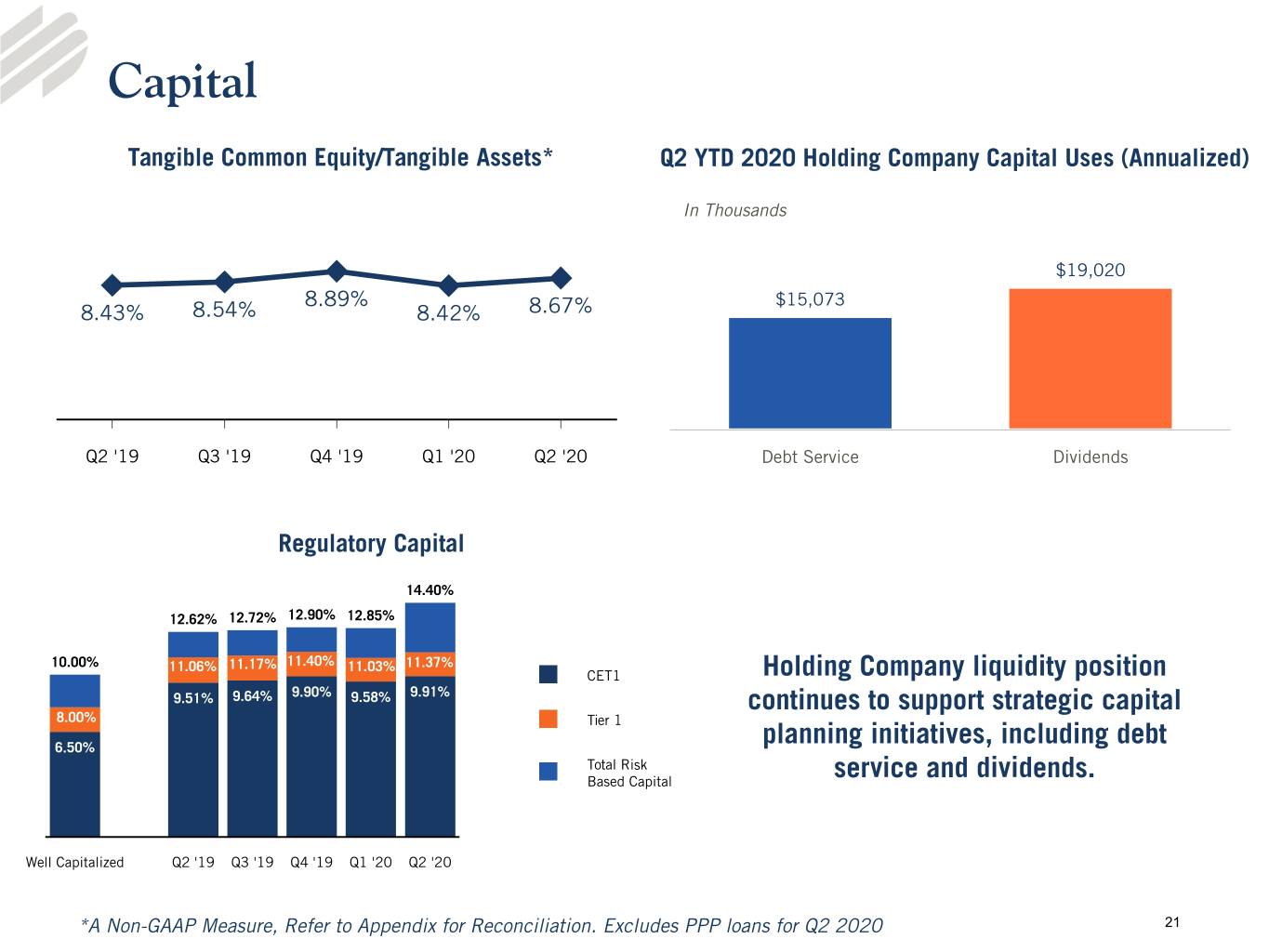
Capital Tangible Common Equity/Tangible Assets* Q2 YTD 2020 Holding Company Capital Uses (Annualized) In Thousands $19,020 8.89% $15,073 8.43% 8.54% 8.42% 8.67% Q2 '19 Q3 '19 Q4 '19 Q1 '20 Q2 '20 Debt Service Dividends Regulatory Capital 14.40% 12.62% 12.72% 12.90% 12.85% 10.00% 11.06% 11.17% 11.40% 11.03% 11.37% CET1 Holding Company liquidity position 9.51% 9.64% 9.90% 9.58% 9.91% continues to support strategic capital 8.00% Tier 1 6.50% planning initiatives, including debt Total Risk Based Capital service and dividends. Well Capitalized ' Q2 '19 Q3 '19 Q4 '19 Q1 '20 Q2 '20 *A Non-GAAP Measure, Refer to Appendix for Reconciliation. Excludes PPP loans for Q2 2020 21
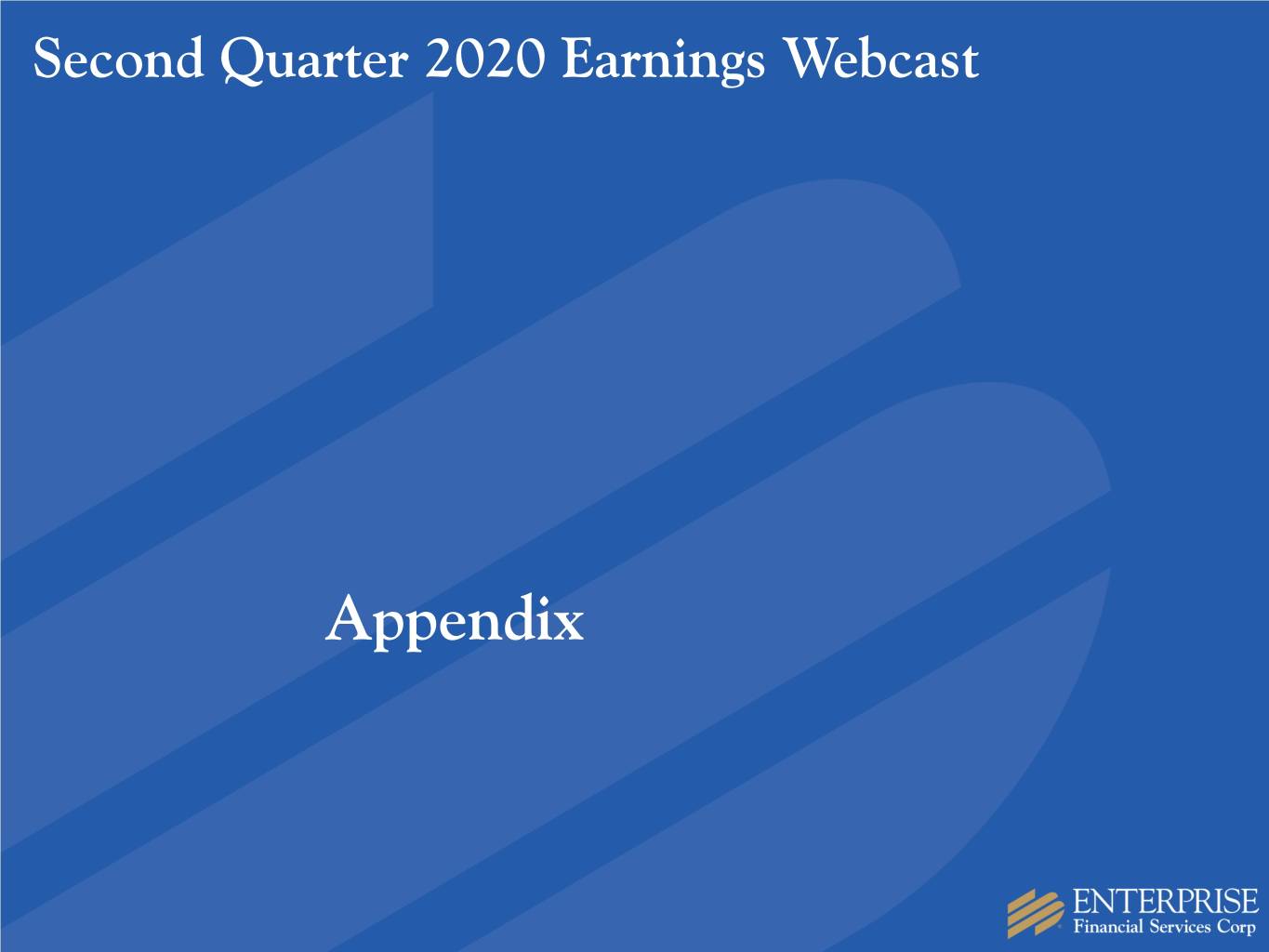
Second Quarter 2020 Earnings Webcast Appendix
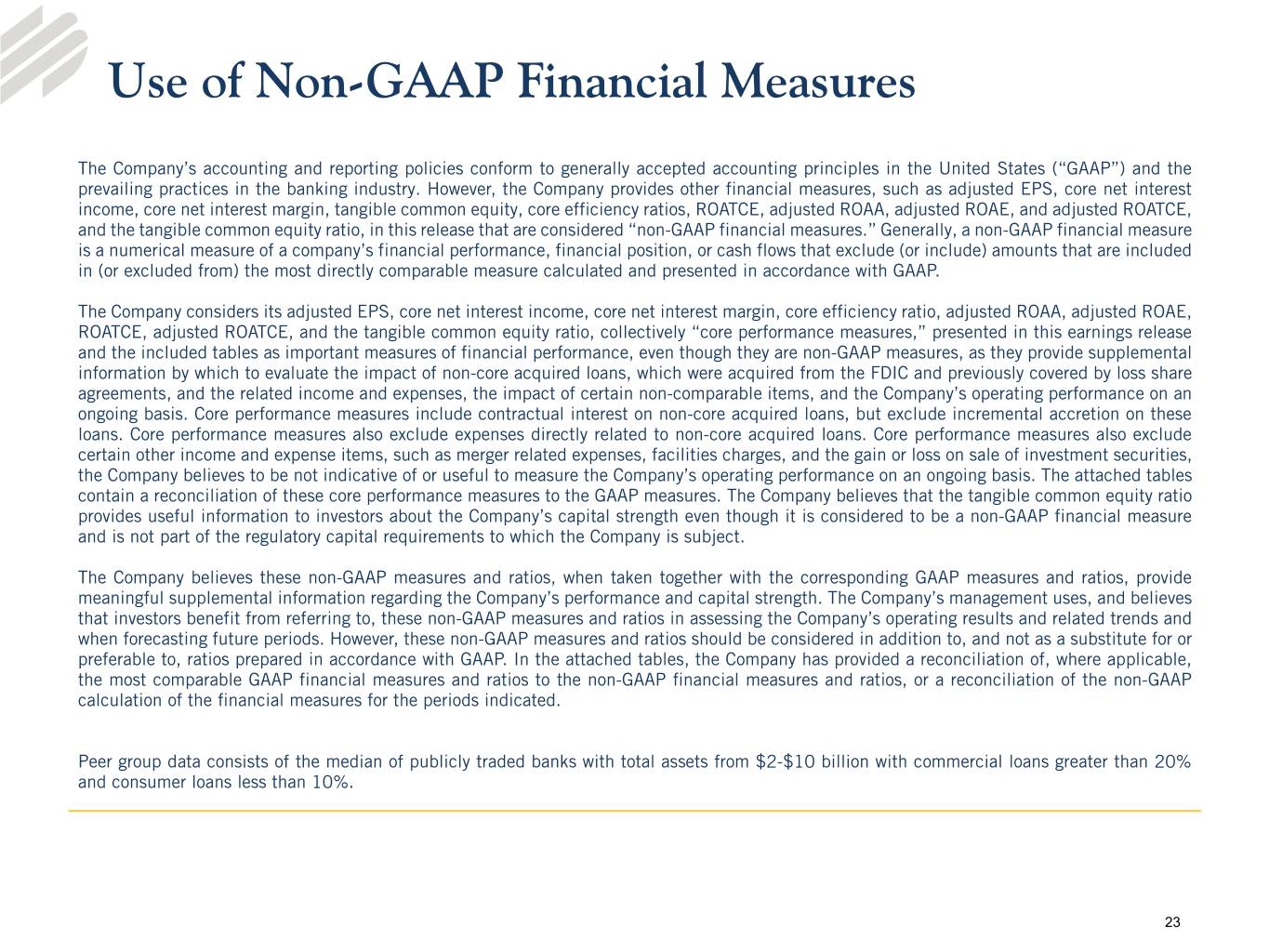
Use of Non-GAAP Financial Measures The Company’s accounting and reporting policies conform to generally accepted accounting principles in the United States (“GAAP”) and the prevailing practices in the banking industry. However, the Company provides other financial measures, such as adjusted EPS, core net interest income, core net interest margin, tangible common equity, core efficiency ratios, ROATCE, adjusted ROAA, adjusted ROAE, and adjusted ROATCE, and the tangible common equity ratio, in this release that are considered “non-GAAP financial measures.” Generally, a non-GAAP financial measure is a numerical measure of a company’s financial performance, financial position, or cash flows that exclude (or include) amounts that are included in (or excluded from) the most directly comparable measure calculated and presented in accordance with GAAP. The Company considers its adjusted EPS, core net interest income, core net interest margin, core efficiency ratio, adjusted ROAA, adjusted ROAE, ROATCE, adjusted ROATCE, and the tangible common equity ratio, collectively “core performance measures,” presented in this earnings release and the included tables as important measures of financial performance, even though they are non-GAAP measures, as they provide supplemental information by which to evaluate the impact of non-core acquired loans, which were acquired from the FDIC and previously covered by loss share agreements, and the related income and expenses, the impact of certain non-comparable items, and the Company’s operating performance on an ongoing basis. Core performance measures include contractual interest on non-core acquired loans, but exclude incremental accretion on these loans. Core performance measures also exclude expenses directly related to non-core acquired loans. Core performance measures also exclude certain other income and expense items, such as merger related expenses, facilities charges, and the gain or loss on sale of investment securities, the Company believes to be not indicative of or useful to measure the Company’s operating performance on an ongoing basis. The attached tables contain a reconciliation of these core performance measures to the GAAP measures. The Company believes that the tangible common equity ratio provides useful information to investors about the Company’s capital strength even though it is considered to be a non-GAAP financial measure and is not part of the regulatory capital requirements to which the Company is subject. The Company believes these non-GAAP measures and ratios, when taken together with the corresponding GAAP measures and ratios, provide meaningful supplemental information regarding the Company’s performance and capital strength. The Company’s management uses, and believes that investors benefit from referring to, these non-GAAP measures and ratios in assessing the Company’s operating results and related trends and when forecasting future periods. However, these non-GAAP measures and ratios should be considered in addition to, and not as a substitute for or preferable to, ratios prepared in accordance with GAAP. In the attached tables, the Company has provided a reconciliation of, where applicable, the most comparable GAAP financial measures and ratios to the non-GAAP financial measures and ratios, or a reconciliation of the non-GAAP calculation of the financial measures for the periods indicated. Peer group data consists of the median of publicly traded banks with total assets from $2-$10 billion with commercial loans greater than 20% and consumer loans less than 10%. 23
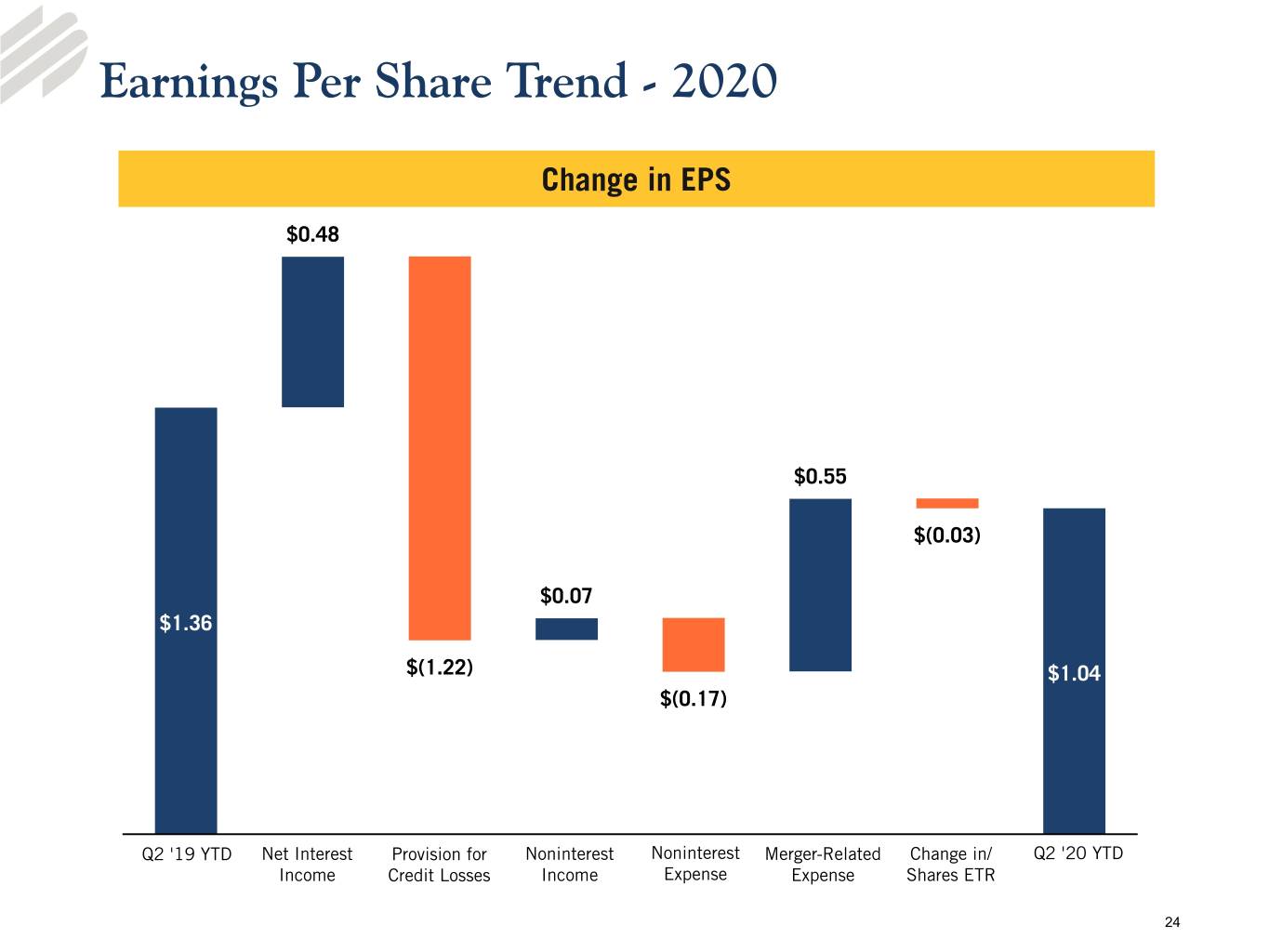
Earnings Per Share Trend - 2020 Change in EPS $0.48 $0.55 $(0.03) $0.07 $1.36 $(1.22) $1.04 $(0.17) Q2 '19 YTD Net Interest Provision for Noninterest Noninterest Merger-Related Change in/ Q2 '20 YTD Income Credit Losses Income Expense Expense Shares ETR 24
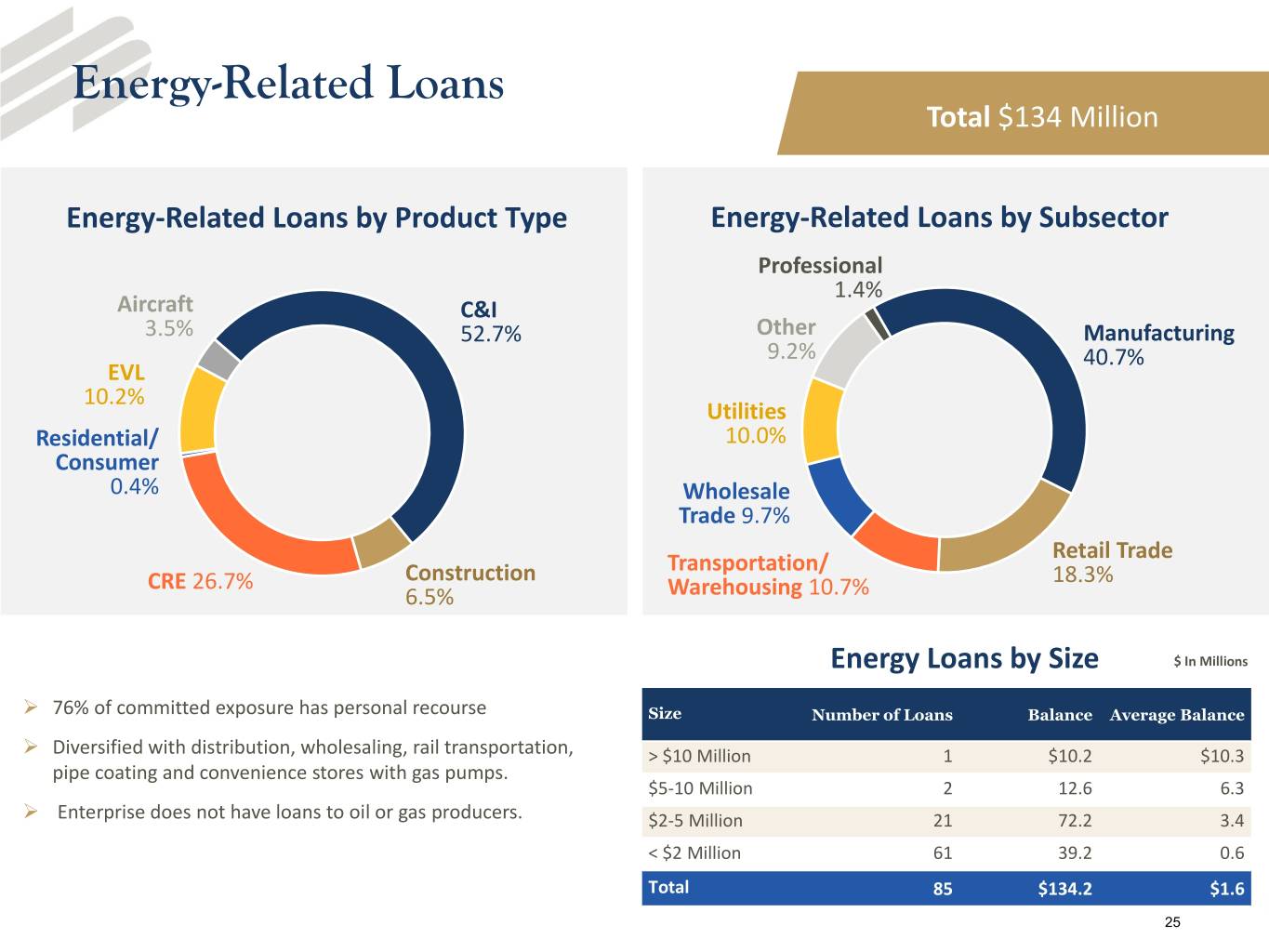
Energy-Related Loans Total $134 Million Energy‐Related Loans by Product Type Energy‐Related Loans by Subsector Professional 1.4% Aircraft C&I 3.5% 52.7% Other Manufacturing 9.2% 40.7% EVL 10.2% Utilities Residential/ 10.0% Consumer 0.4% Wholesale Trade 9.7% Retail Trade Transportation/ CRE 26.7% Construction 18.3% 6.5% Warehousing 10.7% Energy Loans by Size $ In Millions 76% of committed exposure has personal recourse Size Number of Loans Balance Average Balance Diversified with distribution, wholesaling, rail transportation, > $10 Million 1 $10.2 $10.3 pipe coating and convenience stores with gas pumps. $5‐10 Million 2 12.6 6.3 Enterprise does not have loans to oil or gas producers. $2‐5 Million 21 72.2 3.4 < $2 Million 61 39.2 0.6 Total 85 $134.2 $1.6 25

Agricultural Lending Total $191 Million Agricultural Lending by Product Type Agricultural Lending by Subsector Hog & Pig Other Farming 9.5% 32.8% C&I 28.3% CRE ‐ Owner Occupied Misc Crop 8.4% 71.7% Corn Farming Soybean 22.2% Farming 5.2% Dairy Cattle Beef Cattle 5.3% 16.6% Agricultural Loans by Size $ In Millions Experienced farming operations, well secured by Size Number of Loans Balance Average Balance Accounts Receivable $5‐10 Million 6 $45.3 $7.6 Livestock $2‐5 Million 23 72.4 3.1 Real Estate < $2 Million 153 73.3 0.5 Total Diversified portfolio generally supported by production 182 $191.0 $1.0 contracts and hedge strategies 26

Aircraft and Owner-Occupied Auto Dealer Lending/Loans Total $157 Million Aircraft & OO‐Auto Dealer Lending by Aircraft & OO‐Auto Dealer Lending by Product Type Subsector Aircraft Finance Other C&I 49.5% 7.9% 0.3% Educational Residential Services 3.9% 2.2% Retail Trade Manufacturing 78.2% 4.7% CRE‐Owner Transportation Occupied & Warehousing 48.0% 5.3% Aircraft & OO‐Auto Dealer Lending by Size $ In Millions Auto Dealers are primarily secured by owner‐occupied real estate, i.e. no floor‐plan loans Size Number of Loans Balance Average Balance 90% of committed exposure has personal recourse > $10 Million 2 $28.0 $14.0 Aircraft lending, $77.6 Million $5‐10 Million 5 29.0 5.8 Advance rate 70‐75% of retail value $2‐5 Million 17 53.4 3.2 Personal recourse from owners, with a typical < $2 Million 68 46.3 0.7 short‐term 6‐month facility Total 92 $156.7 $1.4 27

Loans Secured by Marketable Securities Total $620 Million Loans Secured by Marketable Loans secured by Marketable Securities by Securities by Product Type Subsector Other 9.0% Agricultural 1.2% Management Finance & C&I 6.3% Insurance 9.1% 84.7% Other Life Insurance 5.9% Premium Finance 83.8% Loans Secured by Marketable Securities by Size $ In Millions Portfolio loans secured by liquid/marketable assets and Size Number of Loans Balance Average Balance within loan to value margins > $10 Million 14 $204.1 $14.6 LIPF Portfolio $5‐10 Million 28 202.3 72.2 The life insurance policies financed have an earnings $2‐5 Million 44 138.9 3.2 floor of 0%, and therefore cannot lose value. Enterprise does not finance variable policies that may lose value. < $2 Million 160 74.5 0.5 Total 246 $619.8 $2.5 28

Retail Commercial Real Estate Total $354 Million Retail CRE Loans by Location Retail CRE Loans by Subsector Other 1.7% Midwest 50.5% Accomodation/ Food Service Southwest 2.7% 30.1% Real Northeast Estate/Rental/ 3.4% Leasing Southeast West 95.6% 1.9% 14.1% Retail CRE Loans by Size $ In Millions 95% of committed exposure has personal recourse Size Number of Loans Balance Average Balance No large shopping mall exposure > $10 Million 6 $79.2 $13.2 Average LTV of 64% $5‐10 Million 10 65.2 6.5 84% of the portfolio can cover 12 months of debt service $2‐5 Million 36 109.7 3.0 from borrower/guarantor liquidity < $2 Million 148 99.5 0.7 Total 200 $353.6 $1.8 29

Reconciliation of Non-GAAP Financial Measures Quarter ended Six months ended Jun 30, Mar 31, Dec 31, Sep 30, Jun 30, Jun 30, Jun 30, ($ in thousands) 2020 2020 2019 2019 2019 2020 2019 CORE PERFORMANCE MEASURES Net interest income $ 65,833 $ 63,368 $ 61,613 $ 63,046 $ 61,715 $ 129,201 $ 114,058 Less: Incremental accretion income 719 1,273 576 2,140 910 1,992 2,067 Core net interest income 65,114 62,095 61,037 60,906 60,805 127,209 111,991 Total noninterest income 9,960 13,408 14,418 13,564 11,964 23,368 21,194 Less: Other income from non-core acquired assets — — 4 1,001 2 — 367 Less: Gain on sale of investment securities — 4 (94) 337 — 4 — Less: Other non-core income 265 — — — 266 265 266 Core noninterest income 9,695 13,404 14,508 12,226 11,696 23,099 20,561 Total core revenue 74,809 75,499 75,545 73,132 72,501 150,308 132,552 Total noninterest expense 37,912 38,673 38,354 38,239 49,054 76,585 88,892 Less: Other expenses related to non-core acquired loans 12 12 33 18 103 24 206 Less: Merger related expenses — — — 393 10,306 — 17,576 Core noninterest expense 37,900 38,661 38,321 37,828 38,645 76,561 71,110 Core efficiency ratio 50.66% 51.21% 50.73% 51.73% 53.30% 50.94% 53.65% NET INTEREST MARGIN TO CORE NET INTEREST MARGIN (TAX EQUIVALENT) Net interest income $ 66,537 $ 63,978 $ 62,141 $ 63,483 $ 62,109 $ 130,515 $ 114,704 Less: Incremental accretion income 719 1,273 576 2,140 910 1,992 2,067 Core net interest income $ 65,818 $ 62,705 $ 61,565 $ 61,343 $ 61,199 $ 128,523 $ 112,637 Average earning assets $ 7,571,196 $ 6,791,459 $ 6,704,506 $ 6,604,083 $ 6,453,001 $ 7,181,328 $ 5,984,348 Reported net interest margin 3.53% 3.79% 3.68% 3.81% 3.86% 3.65% 3.87% Core net interest margin 3.50 3.71 3.64 3.69 3.80 3.60 3.80 30

Reconciliation of Non-GAAP Financial Measures Quarter ended Jun 30, Mar 31, Dec 31, Sep 30, Jun 30, ($ in thousands) 2020 2020 2019 2019 2019 SHAREHOLDERS’ EQUITY TO TANGIBLE COMMON EQUITY AND TOTAL ASSETS TO TANGIBLE ASSETS Shareholders’ equity $ 867,963 $ 846,436 $ 867,185 $ 846,095 $ 825,501 Less: Goodwill 210,344 210,344 210,344 211,251 211,251 Less: Intangible assets 23,196 24,585 26,076 27,626 29,201 Tangible common equity $ 634,423 $ 611,507 $ 630,765 $ 607,218 $ 585,049 Total assets $ 8,357,501 $ 7,500,643 $ 7,333,791 $ 7,346,791 $ 7,181,855 Less: Goodwill 210,344 210,344 210,344 211,251 211,251 Less: Intangible assets 23,196 24,585 26,076 27,626 29,201 Tangible assets $ 8,123,961 $ 7,265,714 $ 7,097,371 $ 7,107,914 $ 6,941,403 Tangible common equity to tangible assets 7.81% 8.42% 8.89% 8.54% 8.43% 31

Second Quarter 2020 Earnings Webcast Q & A